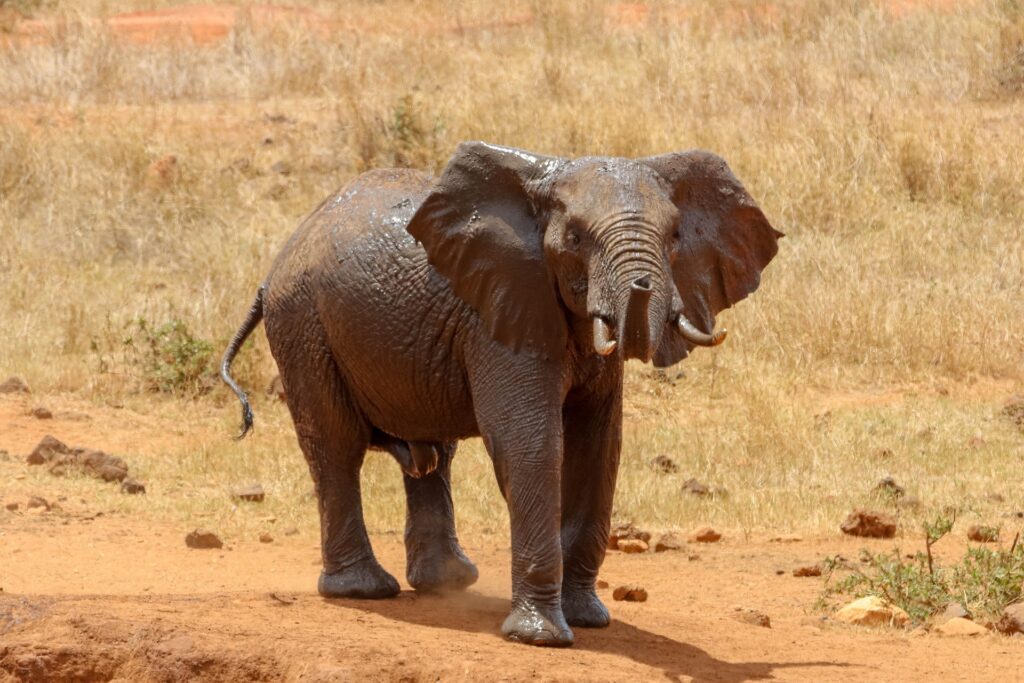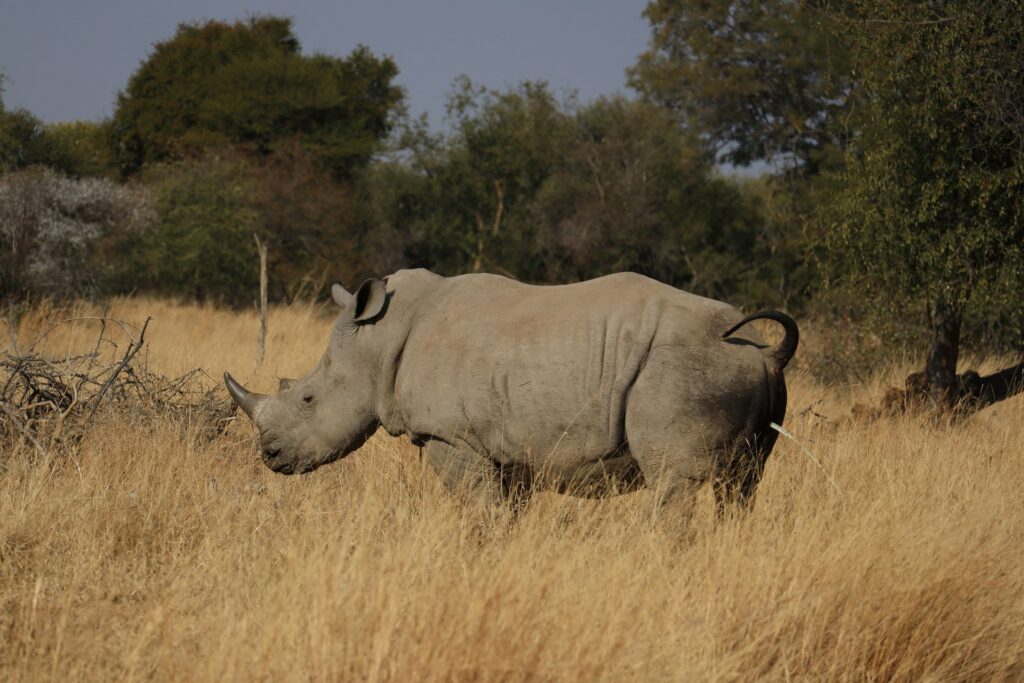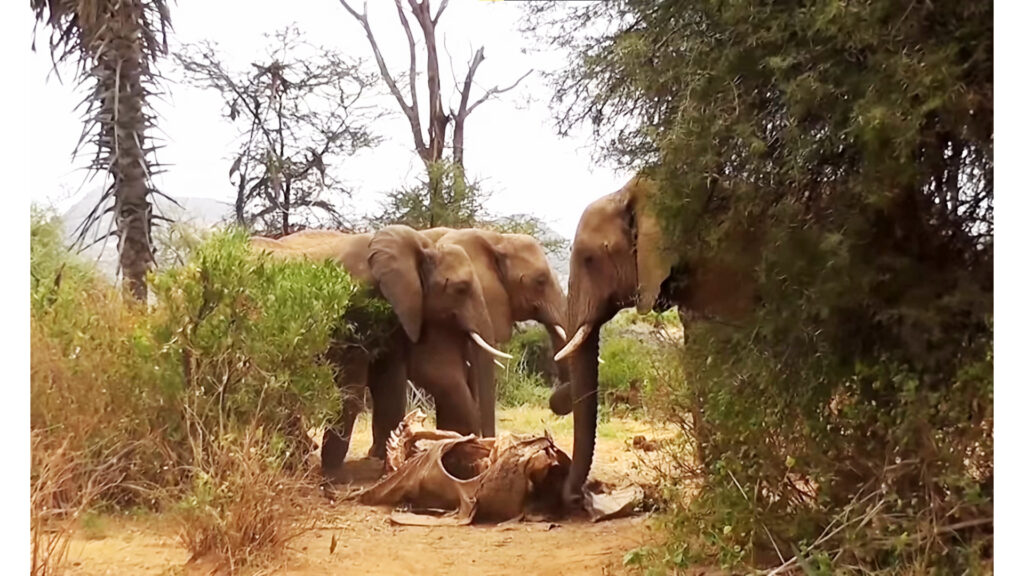How much do you know about Africa’s Big Five animals? I am talking about lions, leopards, elephants, cape buffalo, and rhinos! Sure, they’re some of the most famous and fearsome animals in the world. But did you know that there is more to these animals than what most people know?
For starters, did you know that the term ‘Big Five’ is not because of their size (even though they are pretty big), but for the raw power, mystique, and sheer attitude they bring to the African savannah. So much so that hunters and photographers feared them, they also proved quite hard to track, so they started referring to them as the ‘big five’ animals.
Over time, the name stuck, and today, they’re quite literally the most sought-after animals by tourists in African safaris, and are featured in every African wildlife documentary you can think of.
They are also quite popular in the host nations that they are on their postcards and even currency. In Kenya, the Big Five are on some of the national carrier’s, Kenya Airways (KQ), planes.
But beyond their fame, the Big Five have some pretty wild secrets. We’re talking about behaviours and traits so surprising, they might just change the way you see them. Here are some fascinating facts about Africa’s big five animals;
7 fascinating facts about Africa’s Big Five animals
1. Elephants can “hear” with their feet
I know it may sound unbelievable, but it’s true – elephants can ‘hear’ through their feet. While their large ears help them pick up sounds in the air, their feet are specially adapted to detect seismic vibrations traveling through the ground.
So, how does this happen?
Elephants produce low-frequency sounds called infrasound, which travel long distances –sometimes over 10 kilometres (6 miles). These deep rumbles are often too low for humans to hear, but they can be felt as vibrations in the earth. Other elephants can pick up on these vibrations using sensitive cells in their feet or their trunk tips.
This is something that was tested by scientists in a study conducted in Amboseli National Park, Kenya. Researchers, led by Dr. Caitlin O’Connell, tested elephants’ ability to detect seismic vibrations by using underground speakers to play recorded elephant alarm calls through the ground only, without any airborne sound. When the vibrations reached them, the elephants reacted as if sensing a real threat – freezing, turning toward the source, bunching together, or even retreating.

This ability helps elephants survive in the wild. They can sense the approach of distant herds, detect predators moving nearby, and even pick up on environmental changes like thunderstorms long before they arrive. Some studies even suggest they might use this skill to navigate their massive migration routes.
So, the next time you see an elephant standing still, with one foot slightly raised or pressing down on the ground, it might not just be resting – it could be listening.
2. Lions and hyenas sometimes work together
Lions and hyenas are known for their bitter rivalry. Wildlife documentaries love showing them fighting over carcasses, roaring and cackling in fierce showdowns. But did you know that there are cases where lions and hyenas actually tolerate each other and, in rare situations, even share food or cooperate in hunts? Sounds unbelievable, right?
Several wildlife researchers have observed unusual cases of coexistence and even collaboration between these so-called enemies. One of the most intriguing studies was done in Botswana’s Savuti region and in Ruaha National Park, Tanzania, where researchers noticed that during times of food scarcity, lions and hyenas occasionally fed at the same kill without fighting.
Instead of the usual aggression, they maintained an uneasy truce. The scientists concluded that it was likely the animals chose to reserve their energy and not engage in unnecessary fights. Remember, this is a time when life is literally on the brink.
Even more shocking, some scientists believe that in extremely rare situations, lions and hyenas might even cooperate in hunting. In 2010, a wildlife team in Kenya observed a group of hyenas and lions hunting zebras in a coordinated way. While it’s unclear if it was intentional cooperation or just a moment of opportunism, the fact that they tolerated each other instead of fighting is mind-blowing.
There was another instance when after hyenas killed a waterbuck, a lion casually joined the hyenas and started feeding on the kill.

So, despite being enemies, lions and hyenas share the same environment and often hunt the same prey. Survival in the wild is about strategy, not just rivalry. When resources are low, both species might realize that fighting wastes energy, and it’s smarter to co-exist – even if just for a short time.
Of course, this doesn’t mean they’re best friends. Most of the time, their relationship is very hostile. But these rare cases challenge the idea that nature is always black and white – sometimes, even the fiercest enemies find a way to get along.
3. Leopards can drag prey twice their weight up a tree
When it comes to sheer strength and survival tactics of Africa’s Big Five animals, leopards are in a league of their own. Unlike lions, which rely on teamwork, or even cheetahs, which depend on speed, leopards thrive by being independent, stealthy, and incredibly powerful. One of their most impressive feats is their ability to drag prey that weighs twice their own body weight straight up a tree – a skill that gives them a huge advantage in the African savannah.
The African wilderness is ruled by opportunistic scavengers. A leopard can make a perfect kill, only to lose it within minutes if hyenas or lions are nearby. Lions steal kills all the time, and a single hyena, despite being smaller than a leopard, has such powerful jaws that it can strip a carcass clean in no time. If a clan of hyenas arrives, the leopard stands no chance.

Leopards, being solitary hunters, have figured out the perfect solution: take the meal where no one else can reach it – high up in the trees. Hyenas don’t climb trees! Some lions do climb trees, but they are largely ground animals, and when they climb, they can only get to the lower branches, since higher branches can’t support their weight.
Leopards have a unique combination of raw strength, grip, and climbing technique that makes this possible. Their shoulders and neck muscles are incredibly developed, allowing them to keep a tight grip on large prey while hoisting themselves upwards. Their long, sharp claws act like grappling hooks, giving them excellent traction as they scale trees. Their powerful hind legs provide explosive energy to push off the ground, and their long tails help with balance, ensuring they don’t topple over while dragging an awkwardly hanging carcass.
Interestingly, also, leopards don’t just hoist prey into any tree. They carefully select sturdy trees with thick branches – acacias and marulas are common choices. They also tend to place the kill at just the right height – too low, and hyenas might attempt to climb up; too high, and the branches may not support the carcass’s weight. This suggests a level of calculation and decision-making rather than just brute strength.
4. Buffaloes hold grudges and can seek revenge
The cape buffalo is often overlooked in favour of its more famous Africa’s Big Five counterparts, but seasoned wildlife experts and safari guides will tell you – buffaloes are not to be underestimated. These massive, unpredictable animals are known for their intelligence, strong herd instincts, and, most surprisingly, their ability to hold grudges. Whereas many herbivores react to danger in the moment and move on, buffalo remember threats and have been known to retaliate – sometimes long after the initial encounter.
Take professional hunting, for instance, there have been numerous reports of buffalo recognizing individual hunters, even after long periods, and launching ambushes in retaliation. This behavior has earned them the nickname “Black Death” among hunters, as they have killed more big-game hunters in Africa than any other animal.
Professional hunters have reported instances where a buffalo, after being shot and injured, disappeared into thick vegetation – only to re-emerge later in a calculated counterattack. Unlike panicked prey that runs blindly, buffalo actively stalk their enemies and will charge with terrifying determination.
In addition, buffalo don’t just act alone – their herd mentality makes them even more dangerous. When one member of the herd is attacked, others may rally to its defense, often turning the tables on the predator. Lions, the primary natural threat to buffalo, experience this first-hand.
While lions may succeed in taking down an individual buffalo, the rest of the herd often regroups and counterattacks, trampling and goring lions to death. There have even been cases where buffalo herds have sought out and killed lions hours or even days after an initial attack.
5. Rhinos communicate through dung and urine
When people think of animal communication, they often imagine vocal calls, roars, or even ground vibration. But rhinos? They take a completely different approach – using dung and urine as a messaging system. While it might sound strange, this method is actually an advanced form of olfactory (scent-based) communication that allows rhinos to share important information without even seeing each other.

You see, rhinos don’t just relieve themselves randomly; they deposit their dung in designated spots called middens – essentially, communal “message boards” where multiple rhinos leave their droppings. These middens can be several meters wide, containing dung from numerous individuals, and serve as a critical communication hub.
Each rhino’s dung carries a distinct chemical signature that conveys information about its age, sex, reproductive status, and even its identity. Other rhinos visiting the midden can sniff the dung and instantly know who has been in the area, whether a dominant male is nearby, or if a female is in heat. For territorial males, middens act as a way to mark their territory and warn rivals to stay away.
While dung is used for public broadcasts, urine is more like a direct message. Rhinos will spray or dribble urine strategically to mark their movements, helping them navigate and recognize familiar areas. Males frequently urinate near their dung piles to reinforce their presence, while females in estrus (ready to mate) leave scent trails to attract potential mates.
Interestingly, white rhinos and black rhinos have slightly different ways of using scent. White rhinos, which are more social, tend to have larger, more communal middens, whereas black rhinos, which are more solitary, rely more on urine spraying to signal their presence.
6. White rhinos are not actually white, and black rhinos aren’t really black
One of the biggest misconceptions about rhinos is that white rhinos are white and black rhinos are black. In reality, both species are actually grey, and their names have nothing to do with their colour. So, where did these misleading names come from?
The name “white rhino” actually comes from a misinterpretation of the Dutch word “wijde,” which means “wide”- referring to the animal’s broad, square-shaped mouth. Early English-speaking settlers in South Africa misheard “wijde” as “white,” and the name stuck. Despite the name, white rhinos are not white at all – their skin is typically a dusty grey, often coated in mud from wallowing.
If white rhinos aren’t white, then black rhinos must be black, right? Wrong. Black rhinos are also grey, and their name has no real connection to their skin colour. Some believe they were called “black” simply to contrast with the “white” rhino, while others suggest it might be due to their tendency to wallow in darker, muddier areas, which sometimes makes them appear darker.
So, what’s the difference between these two animals?
The biggest distinction between them is their mouth shape and feeding behaviour.

White rhinos have a wide, square-shaped mouth, perfectly adapted for grazing on grasses. And so, they prefer open grasslands and spend much of their time feeding with their heads lowered.
On the other hand, black rhinos have a pointed, hooked upper lip, which allows them to grab leaves and twigs from bushes and small trees. Because of this, black rhinos are often found in denser, shrubbier habitats.
These adaptations are so distinct that even if you saw a rhino covered in mud (hiding its true colour), you could immediately tell whether it’s a black or white rhino just by looking at its mouth.
7. Elephants Mourn Their Dead
Elephants are known for their intelligence, strong social bonds, and emotional depth, but one of their most fascinating behaviours is their ability to mourn their dead. You see, most animals simply move on when a member of their group dies. Elephants, however, exhibit behaviours that are remarkably similar to human grieving rituals – showing signs of sadness, paying respects, and even visiting the bones of their deceased years later.
When an elephant dies, whether from natural causes or predation, its family and even unrelated elephants may stop, gather, and inspect the body. They use their trunks and feet to touch and nudge the carcass, sometimes trying to lift the fallen elephant as if attempting to wake it up. They will often stand near the body in silence, a stark contrast to their usually vocal nature. Some individuals even show visible distress – ears drooping, eyes leaking fluid, and a general sense of solemnity.

The other thing is how elephants treat the bones of their dead. Even years after an elephant has died, if another elephant comes across the skeleton, it will pause, touch, and examine the skull and tusks. Unlike other objects in their environment, elephants seem to recognize the remains of their own kind and interact with them differently.
While we can’t say for certain what an elephant feels, their behavior suggests deep emotional attachment. There have been cases where elephants visibly mourn the loss of a close family member, refusing to leave the body for days, barely eating, and even showing signs of depression.
One famous case involved Eleanor, a matriarch elephant in Kenya’s Samburu National Reserve. When she collapsed from illness, another female elephant, Grace, rushed to her side, trying to lift her with her trunk and tusks. Even after Eleanor died, elephants from different families visited her body over several days, touching it and standing vigil.
Scientists believe that elephants’ mourning behaviour is linked to their strong familial bonds and high intelligence. They live in tight-knit herds, led by a matriarch, and rely on social structure for survival. The loss of a member, especially a matriarch, can impact the entire herd, so acknowledging death may be part of their way of processing the change.
The best safari destinations to see Africa’s Big Five animals
Seeing Africa’s Big Five animals in the wild is the ultimate safari experience. If you’re planning a safari and want the best chance to spot all five, here are the top destinations that should be on your bucket list;
Maasai Mara National Reserve, Kenya
Kenya’s Maasai Mara is world-famous for its incredible wildlife density, making it one of the best places to see Africa’s Big Five animals in their natural habitat. The open plains provide prime viewing opportunities, especially during the Great Migration, when millions of wildebeest migrate into the Mara. Lions and leopards are particularly abundant here, while elephants and buffalo roam freely all year round. Rhinos can also be spotted in certain areas of the reserve.
Serengeti National Park, Tanzania
Right next to the Maasai Mara, Tanzania’s Serengeti National Park is another iconic safari destination. This vast wilderness is home to all of the Big Five animals, with leopards frequently seen in the Seronera region and rhinos found in the Moru Kopjes. The Serengeti’s endless plains make for dramatic predator-prey encounters, offering unforgettable wildlife experiences.
Kruger National Park, South Africa
For those seeking a mix of adventure and comfort, Kruger National Park in South Africa is an excellent choice. It boasts one of the highest concentrations of Africa’s Big Five animals, with reliable sightings of all five species. The park’s well-developed road network and luxury lodges make it one of the top picks for first-time safari-goers. Private reserves like Sabi Sands and Timbavati offer even closer encounters.
Chobe National Park, Botswana
If elephants are at the top of your list, Chobe National Park is a must-visit. It has Africa’s largest elephant population, with massive herds gathering along the Chobe River. Lions and buffalo are frequently seen, and while leopards and rhinos are more elusive, they are still present in the park’s remote areas.
South Luangwa National Park, Zambia
Zambia’s South Luangwa National Park is a hidden gem known for its walking safaris and high leopard density. It’s one of the best places to see leopards in action, especially during night drives. The park also has healthy populations of lions, elephants, and buffalo. While rhinos are absent, nearby North Luangwa National Park has a small population of black rhinos.
Conclusion
Africa’s Big Five are more than just Africa’s most iconic animals – they are intelligent, powerful, and full of surprises.
These fascinating facts remind us that these animals are not just symbols of the wild but complex, deeply connected beings with unique adaptations that help them survive. The more we learn about them, the more we appreciate their place in nature – and the greater our responsibility to protect them for future generations.

